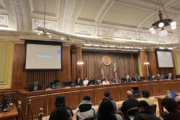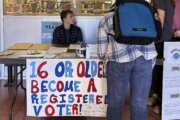Five years after a violent weekend in Charlottesville, Virginia, surrounding the white nationalist Unite The Right rally, the commonwealth’s former homeland security chief says challenges remain in preventing a recurrence.
“Some of the very same groups that were involved in Charlottesville stormed the United States Capitol,” on Jan. 6, 2021, said Brian Moran, who was Virginia’s Secretary of Public Safety and Homeland Security, under Gov. Ralph Northam, in a WTOP interview. “In 2017, they unmasked themselves.”
Moran said lessons were learned about preparing for large-scale gatherings in the wake of Charlottesville weekend, in which hundreds of white nationalists and neo-Nazis marched through the University of Virginia campus with tiki torches. The next afternoon, James Alex Fields drove through a group of counterprotesters, killing Heather Heyer, and injuring dozens more.
“Intelligence gathering and dissemination is essential,” Moran said, saying the state — like others — has a fusion center, which was established after Sept. 11, 2011.
According to the fusion center website, “A fusion center is a collaborative effort of state and federal agencies working in conjunction with local partners to share resources, expertise, and/or information to better identify, detect, prevent, and respond to terrorist and criminal activity utilizing an all crimes/all hazards approach.”
In addition to the agencies charged with gathering intelligence, according to Moran, “It’s gathered from even individuals — see something, say something.”
An ongoing challenge is ensuring that the information is shared, since historically there has been some turf-protecting between federal and state agencies.
“It’s essential those silos and barriers continue to be eliminated, but I’m not here to tell you that has been so,” Moran said.
Balancing First Amendment and public safety
“In 2017, we were concerned about achieving the right balance, and we didn’t want to militarize the streets of Charlottesville,” said Moran. “In fact, we were sued by the ACLU.”
A major problem in security during Charlottesville was the proximity between protesters and counterprotesters, which led to hand-to-hand battle on the streets.
“You have to prioritize public safety when you have groups that have demonstrated their proclivity to commit acts of violence,” said Moran. “You can achieve a reasonable balance where First Amendment rights are respected.”
An extensive report by former U.S. Attorney Tim Heaphy, requested by Charlottesville officials after the violence, criticized police planning as “inadequate and disconnected.” Charlottesville police supervisors failed to provide adequate training to line officers and police planners waited too long to request assistance from state emergency response officials, the report said.
“It can be a difficult balance to achieve, when you have thousands on one side and thousands on the other to keep them separate, and to allow them to use the public square,” said Moran. “Individuals should have the opportunity to express themselves, whether you like or dislike what they have to say.”
Moran said “courts will recognize and allow certain barriers to occur,” to keep opposing groups physically separated.
“It can be an inconvenience,” for those hoping to engage opponents, Moran acknowledges.
“But, you’ve got to learn from the past,” Moran said, which led to local and state police imposing some access restrictions in 2018, on the one-year anniversary of the Unite The Right rally.
Moran pointed to later instances in Virginia, in which the strategy succeeded, including the 2020 and 2021 Lobby Day protests in Richmond.
“In 2020 when gun rights groups came to the Virginia Capitol, we had 15,000 people demonstrating for Second Amendment rights. We imposed some restrictions on their access to the capital,” said Moran. “They were not happy about it, but at the end of the day, everyone went home safely.”
Moran said the Richmond protests were proof that a proper balance of free speech and public safety is achievable.
“Protesters — for and against — law enforcement, members of the community, everyone went home safely, and were able to express their views.”








